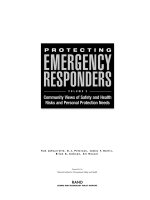Emergency and trauma radilogy
Bạn đang xem bản rút gọn của tài liệu. Xem và tải ngay bản đầy đủ của tài liệu tại đây (20.94 MB, 415 trang )
Editor
Daniel B. Nissman MD, MPH, MSEE
Assistant Professor of Radiology
Division Chief, Musculoskeletal Imaging Division
Department of Radiology
University of North Carolina at Chapel Hill
Chapel Hill, North Carolina
Associate Editors
Katherine R. Birchard, MD
Associate Professor of Radiology
Cardiothoracic Imaging Division
Director, Medical Student Education
Department of Radiology
University of North Carolina at Chapel Hill
Chapel Hill, North Carolina
Benjamin Y. Huang, MD, MPH
Associate Professor of Radiology
Director, Neuroradiology Fellowship
Neuroradiology Division
Department of Radiology
University of North Carolina at Chapel Hill
Chapel Hill, North Carolina
Ellie R. Lee, MD
Assistant Professor of Radiology
Abdominal Imaging Division
Department of Radiology
University of North Carolina at Chapel Hill
Chapel Hill, North Carolina
Contributors
Scott S. Abedi, MD
Resident, Diagnostic Radiology
Department of Radiology
University of North Carolina at Chapel Hill
Chapel Hill, North Carolina
Ana Lorena Abello, MD
Neuroradiologist
Hospital Universitario del Valle
Cali, Colombia
Michael K. Altenburg, MD, PhD
Resident, Diagnostic Radiology
Department of Radiology
University of North Carolina School of Medicine
Chapel Hill, North Carolina
Bryan E. Ashley, MD
Resident, Diagnostic Radiology
Department of Radiology
University of North Carolina School of Medicine
Chapel Hill, North Carolina
Christopher J. Atkinson, MD
Resident, Diagnostic Radiology
Department of Radiology
San Antonio Military Medical Center
San Antonio, Texas
Andrew F. Barnes, MD
Resident, Diagnostic Radiology
Department of Radiology
University of North Carolina at Chapel Hill
Chapel Hill, North Carolina
Mustafa R. Bashir, MD
Director of MRI
Associate Professor of Radiology
Center for Advanced Magnetic Resonance Development
Duke University Medical Center
Durham, North Carolina
Katherine R. Birchard, MD
Associate Professor of Radiology
Cardiothoracic Imaging Division
Director, Medical Student Education
Department of Radiology
University of North Carolina at Chapel Hill
Chapel Hill, North Carolina
Kelsey R. Budd, MD
Resident, Diagnostic Radiology
Department of Radiology
University of North Carolina School of Medicine
Chapel Hill, North Carolina
Kaleigh L. Burke, MD
Resident, Diagnostic Radiology
Department of Radiology
University of North Carolina School of Medicine
Chapel Hill, North Carolina
Lauren M.B. Burke, MD
Assistant Professor of Radiology
Abdominal Imaging Division
Department of Radiology
University of North Carolina School of Medicine
Chapel Hill, North Carolina
Lazaro D. Causil, MD
Research Fellow
Department of Radiology
University of North Carolina
Chapel Hill, North Carolina
Andy K. Chon, MD
Fellow, Abdominal Imaging and Intervention
Department of Radiology
Brigham and Women's Hospital
Boston, Massachusetts
Wui Chong, MD
Associate Professor of Radiology
Abdominal Imaging Division
Interim Chief, Abdominal Imaging
Fellowship Director, Abdominal Imaging
Associate Professor of OB-GYN
Chief of Diagnostic Ultrasound
Department of Radiology
University of North Carolina School of Medicine
Chapel Hill, North Carolina
Richard L. Clark, MD, FACR
Professor Emeritus
Department of Radiology
University of North Carolina School of Medicine
Chapel Hill, North Carolina
Stephanie F. Coquia, MD
Assistant Professor of Radiology and Radiological Science
Department of Radiology
The Johns Hopkins Hospital
Baltimore, Maryland
James C. Darsie, MD
Resident, Diagnostic Radiology
Department of Radiology
University of North Carolina at Chapel Hill
Chapel Hill, North Carolina
John Duncan, MD
Resident, Diagnostic Radiology
Department of Radiology
St. Barnabas Medical Center
Livingston, New Jersey
Ryan E. Embertson, MD
Resident, Diagnostic Radiology
Department of Radiology
University of North Carolina at Chapel Hill
Chapel Hill, North Carolina
Elena Fenu, BS
Medical Student
University of North Carolina
Chapel Hill, North Carolina
Joseph C. Fuller III, MD
Resident, Diagnostic Radiology
Department of Radiology
University of Washington
Seattle, Washington
Sam A. Glaubiger, BS
Medical Student
University of North Carolina at Chapel Hill
Chapel Hill, North Carolina
Rajan T. Gupta, MD
Assistant Professor of Radiology
Director, Abdominal Imaging Fellowship Program
Duke University Medical Center
Durham, North Carolina
Tamar Gurunlian, BSc
Medical Student
Ross University School of Medicine
Portsmouth, Dominica
Brian D. Handly, MD
Assistant Professor of Radiology
Abdominal Imaging Division
Department of Radiology
University of North Carolina at Chapel Hill
Chapel Hill, North Carolina
Kelly L. Hastings, MD
Resident, Diagnostic Radiology
Department of Radiology
University of North Carolina at Chapel Hill
Chapel Hill, North Carolina
Bryan M. Hoag, MD
Resident, Diagnostic Radiology
Department of Radiology
University of North Carolina at Chapel Hill
Chapel Hill, North Carolina
Benjamin Y. Huang, MD, MPH
Associate Professor of Radiology
Director, Neuroradiology Fellowship
Neuroradiology Division
Department of Radiology
University of North Carolina at Chapel Hill
Chapel Hill, North Carolina
Sheryl G. Jordan, MD
Associate Professor of Radiology
Director GME
Department of Radiology
University of North Carolina School of Medicine
Chapel Hill, North Carolina
Christopher J. Karakasis, MD
Fellow, Neuroradiology Division
Department of Radiology
University of North Carolina at Chapel Hill
Chapel Hill, North Carolina
Eun Lee Langman, MD
Assistant Professor of Radiology
Division of Breast Imaging
Department of Radiology
University of North Carolina School of Medicine
Chapel Hill, North Carolina
Ellie R. Lee, MD
Assistant Professor of Radiology
Abdominal Imaging Division
Department of Radiology
University of North Carolina at Chapel Hill
Chapel Hill, North Carolina
Sheila S. Lee, MD
Assistant Professor of Radiology
Division of Breast Imaging
Department of Radiology
University of North Carolina School of Medicine
Chapel Hill, North Carolina
E. Matthew Lopez II, DO
Fellow, Neuroradiology
Department of Neuroradiology
University of North Carolina
Chapel Hill, North Carolina
Troy H. Maetani, MD
Assistant Professor of Radiology
Division of Musculoskeletal Imaging
Department of Radiology
University of North Carolina School of Medicine
Chapel Hill, North Carolina
Brian P. Milam, MD
CPT, U.S. Army, Medical Corps
Orthopaedic Surgery Resident
Department of Surgery
Madigan Army Medical Center
Tacoma, Washington
Ho Chia Ming, MBBS (Singapore), FRCR (London)
Consultant, Diagnostic Radiology
Department of Diagnostic Radiology
Singapore General Hospital
Adjunct Associate Professor
Duke-National University of Singapore
Singapore
Aaron Moore, BS
Medical Student
University of North Carolina School of Medicine
Chapel Hill, North Carolina
Eduardo V. Moroni, MD
Fellow, Abdominal Imaging Division
Department of Radiology
University of North Carolina School of Medicine
Chapel Hill, North Carolina
Malik Mossa-Basha, MD
Resident, Diagnostic Radiology
Department of Radiology
University of North Carolina School of Medicine
Chapel Hill, North Carolina
Niyati Mukherjee, MD
Assistant Professor of Radiology
Abdominal Imaging Division
Department of Radiology
University of North Carolina at Chapel Hill
Chapel Hill, North Carolina
Brett R. Murdock, MD
Fellow, Cardiothoracic Imaging Division
Department of Radiology
University of North Carolina at Chapel Hill
Chapel Hill, North Carolina
Abdul O. Nasiru, MD
Resident, Diagnostic Radiology
Department of Radiology
Emory University
Atlanta, Georgia
Daniel Nissman, MD, MPH, MSEE
Assistant Professor of Radiology
Division Chief, Musculoskeletal Imaging Division
Department of Radiology
University of North Carolina at Chapel Hill
Chapel Hill, North Carolina
Peter J. Noone, BS
Medical Student
University of North Carolina at Chapel Hill
Chapel Hill, North Carolina
Renato H. Nunes, MD
Neuroradiologist
Neuroradiology Division
Santa Casa de Sao Paulo
Sao Paulo, Brazil
Neuroradiologist
Neuroradiology Division
Grupo Fleury
Sao Paulo, Brazil
Kwaku A. Obeng, MD
Fellow, Neuroradiology Division
Department of Radiology
University of North Carolina at Chapel Hill
Chapel Hill, North Carolina
Jorge D. Oldan, MD
Assistant Professor of Radiology
Division of Nuclear Medicine
Department of Radiology
University of North Carolina School of Medicine
Chapel Hill, North Carolina
Parth C. Patel, MD
Resident, Diagnostic Radiology
Department of Radiology
University of North Carolina at Chapel Hill
Chapel Hill, North Carolina
Kavya E. Reddy, MD
Resident, Diagnostic Radiology
Department of Radiology
University of North Carolina at Chapel Hill
Chapel Hill, North Carolina
Kenny E. Rentas, MD
Fellow, Neuroradiology Division
Department of Radiology
University of North Carolina at Chapel Hill
Chapel Hill, North Carolina
Lana M. Rivers, MD
Resident, Diagnostic Radiology
Department of Radiology
University of North Carolina at Chapel Hill
Chapel Hill, North Carolina
Adam T. Ryan, MD
Fellow, Musculoskeletal Imaging Division
Department of Radiology
University of North Carolina at Chapel Hill
Chapel Hill, North Carolina
Shaun R. Rybak, MD
Resident, Diagnostic Radiology
Department of Radiology
University of North Carolina at Chapel Hill
Chapel Hill, North Carolina
Cassandra M. Sams, MD
Assistant Professor of Radiology
Pediatric Imaging Division
Department of Radiology
University of North Carolina at Chapel Hill
Chapel Hill, North Carolina
Denny Scaria, BS
Medical Student
University of North Carolina School of Medicine
Chapel Hill, North Carolina
Cody J. Schwartz, MD, MPH
Resident, Diagnostic Radiology
Department of Radiology
University of North Carolina at Chapel Hill
Chapel Hill, North Carolina
Francisco Sepulveda, MD
Research Fellow
Department of Radiology
University of North Carolina
Chapel Hill, North Carolina
Tiffany M. Sills, MD, PhD
Resident, Diagnostic Radiology
Department of Radiology
University of North Carolina School of Medicine
Chapel Hill, North Carolina
Jiheon Song, MSc
Medical Student
University College Cork School of Medicine
Cork, Ireland
Ami V. Vakharia, MD
Resident, Diagnostic Radiology
Department of Radiology
University of North Carolina at Chapel Hill
Chapel Hill, North Carolina
Daniel M. Varón, MD
Neuroradiologist
Hospital Universitario del Valle
Cali, Colombia
Audrey R. Verde, PhD
Medical Student
University of North Carolina School of Medicine
Chapel Hill, North Carolina
Shaun R. Wagner, DO
Fellow, Neuroradiology Division
Department of Radiology
University of North Carolina at Chapel Hill
Chapel Hill, North Carolina
Joshua A. Wallace, MD, MPH
Resident, Diagnostic Radiology
Department of Radiology
University of North Carolina Hospitals
Chapel Hill, North Carolina
Sarah B. Wilson, BS
Medical Student
University of North Carolina School of Medicine
Chapel Hill, North Carolina
Alexander D. Wyckoff, MD
Resident, Diagnostic Radiology
Department of Radiology
University of North Carolina at Chapel Hill
Chapel Hill, North Carolina
Dedication
To my wife Kathleen and my daughters Irene and Vera for their love and understanding. To all my teachers and
colleagues who have and continue to motivate me with excellence. To all the residents and fellows I've had the
privilege to train—you are the reason I'm an academic radiologist!
Daniel B. Nissman
To all the patients in this work, whose images have contributed to our knowledge of disease.
Katherine R. Birchard
To my family and to the UNC community. Go Heels!
Benjamin Y. Huang
To my husband Terry and my children Ashley and Kayley for their never-ending love, support, and
understanding. To my parents Thomas and Lisa Lee for raising, educating, and supporting me. To all my
residents, fellows, and medical student trainees for constantly stimulating my mind, and inspiring me to be a
better teacher. To all my faculty and colleagues, who have been a pleasure and privilege to practice, research,
and collaborate with.
Ellie R. Lee
Publisher's Foreword
Teaching files are one of the hallmarks of education in radiology. When there was a need for a comprehensive
series to provide the resident and practicing radiologist with the kind of personal consultation with the experts
normally found only in the setting of a teaching hospital, Wolters Kluwer was proud to have created a series that
answers this need.
Actual cases have been culled from extensive teaching files in major medical centers. The discussions presented
mimic those performed on a daily basis between residents and faculty members in all radiology departments.
This series is designed so that each case can be studied as an unknown. A consistent format is used to present
each case. A brief clinical history is given, followed by several images. Then, relevant findings, differential
diagnosis, and final diagnosis are given, followed by a discussion of the case. The authors thereby guide the
reader through the interpretation of each case.
Cases have been randomized to better prepare the reader for the challenges of the clinical setting. In addition, to
answer the growing demand for electronic content, we have included more cases online, which has left us, in
turn, able to offer a more cost-effective product.
We hope that this series will continue to be a trusted teaching tool for radiologists at any stage of training or
practice and that it will also be a benefit to clinicians whose patients undergo these imaging studies.
The Publisher
Preface
The field of radiology is traditionally subdivided into body systems, which allows for both ease of study and
specialization. Imaging of the acutely ill patient, the subject of emergency and trauma radiology, cuts across all of
these traditional organ-based subdivisions. Historically, very few case review texts have been written exclusively
on the imaging of the acutely ill patient. Instead, radiologists, including residents, who cover the emergency
department must draw on their experience in each of the traditional body systems to interpret the wide variety of
acute imaging pathology. This text is intended fill this gap. Our survey of the field of emergency and trauma
radiology will be most useful for residents preparing for and taking call. Naturally, this work will also interest
those preparing for board examinations and practicing radiologists desiring additional exposure to emergency
radiology.
This text is a collaborative work. Expert subspecialty radiologists have selected and edited the cases within one
of four general areas: Dr. Lee - abdominal, Dr. Huang - central nervous system, Dr. Nissman - musculoskeletal,
and Dr. Birchard - thoracic. Both adult and pediatric cases are represented. The complete collection of 300
cases is contained in the online version of this work. A subset of 100 of these cases is presented in the print
version and represents a sampling of true emergencies, urgencies, and concepts that the editors felt needed to
be emphasized for the radiology resident. Cases are presented in random order to mimic the appearance of
cases in a real emergency radiology practice.
Each case is presented in a sequence that models the actual interpretive process: one to four images, an image
description, a differential diagnosis, the diagnosis, and a discussion. These are followed by brief sections
summarizing what the referring physician needs to know, reporting responsibilities, and one or more questions
for further thought. The questions for further thought may expound on the differential diagnosis, the mechanism
of injury, anatomical considerations, or technical factors related to imaging.
In the acute care setting, there are certain expectations regarding reporting. True emergencies require immediate
direct communication with the referring clinician whereas all other cases require a timely report. The definition of
timely is often dependent on patient setting, modality, and contractual obligations. The “Reporting
Responsibilities” section of each case assumes that the patient is in a high volume emergency department where
cases not meeting the definition of a true emergency will still be acted on in a timely fashion. Alternatively, in an
outpatient setting, some non-emergent diagnoses may merit a phone call to ensure expedited subspecialty care
or that the implications of an unusual diagnosis are appreciated.
Many acute pathological entities have been classified, graded, and typed with the hope of predicting prognosis
and/or guiding management. This is particularly true of orthopedic trauma. Unfortunately, very few classification
systems are able to achieve these goals in all situations. When appropriate, the most commonly used
classification system is described with the recognition that it is often not perfect and that there may be other
classifications that are used by practicing physicians. Unless there is one universally accepted classification
system for an entity, it is better to know the elements that serve as the bases for these systems and describe
those in the report; this allows the referring physician to make an assignment based on their own preferences.
In summary, it is our hope that after you have studied all the cases in this book (print and online) that you will be
well prepared to handle the variety of pathology seen in the acute care setting with confidence.
Daniel B. Nissman, MD, MPH, MSEE
Katherine R. Birchard, MD
Benjamin Y. Huang, MD, MPH
Ellie R. Lee, MD
Acknowledgments
This book would not be possible without the hard work of all of our contributors, including medical students,
residents, fellows, and faculty. In particular, we would like to acknowledge the participation of the faculty
contributors who have done so in the face of very high clinical workloads in addition to other teaching, research,
and administrative responsibilities.
Daniel B. Nissman
Katherine R. Birchard
Benjamin Y. Huang
Ellie R. Lee
Case 1
Hemorrhagic Venous Sinus Thrombosis
Shaun R. Rybak
CLINICAL HISTORY
25-year-old female with history of Crohn's disease presenting with nausea, dehydration, and headache.
FIGURE 1A
FIGURE 1B
FIGURE 1C
FIGURE 1D
P.2
FINDINGS
Figure 1A: Axial unenhanced computed tomography (CT image) demonstrates a posterior left temporal lobe
hemorrhage. Figure 1B: Axial T1 precontrast magnetic resonance imaging (MRI) demonstrates the hematoma (
larger arrow) to be of heterogeneous iso- to slightly hyperintense signal relative to the adjacent brain
parenchyma. In addition, there is a T1 hyperintense curvilinear cordlike structure posterior to the area of edema
in the left temporal lobe ( small hatched arrow). Figure 1C: Axial GRE image demonstrates an area of signal
dropout with blooming ( larger arrow) in the area of the hematoma. There are also thin curvilinear, cordlike
structures posterior to the hematoma ( small hatched arrows). Figure 1D: Anteroposterior maximum intensity
projection (MIP) reconstruction from a magnetic resonance venography (MRV) of the head demonstrates loss of
flow-related signal in the left transverse sinus ( arrowheads) and sigmoid sinus.
DIFFERENTIAL DIAGNOSIS
The findings on the images provided are diagnostic of a hemorrhagic venous infarction caused by cerebral
venous thrombosis. Based on the CT alone, a hemorrhagic metastasis, hemorrhagic primary brain malignancy,
or ruptured arteriovenous malformation (AVM) could be considered; however, the ancillary findings allow the
correct diagnosis to be made. Amyloid angiopathy can also cause peripheral parenchymal hemorrhages, but this
disease occurs in a much older patient population.
DIAGNOSIS
Cerebral venous sinus thrombosis with hemorrhagic venous infarction.
DISCUSSION
Cerebral venous thrombosis (including the dural venous sinuses and cortical veins) can be caused by a long list
of entities that may induce a hypercoagulable state in patients. These include genetic causes (including factor V
Leiden mutation, which is thought to be the most common cause of sporadic CVT), pregnancy, dehydration, oral
contraceptives, infection/inflammation, and malignancy.
The pathophysiology behind the hemorrhagic infarct usually occurs as follows: dural sinus thrombosis → clot
progresses into cortical veins → increased venous pressure → blood-brain barrier breakdown with vasogenic
edema and hemorrhage → venous infarct with cytotoxic edema.
Although it can occur at any age, almost 90% of cerebral venous thrombosis in adults occurs between the ages
of 16 and 60 years, with most occurring between 21 and 50 years. Roughly 75% occur in women. The
thrombosis is usually seen in more than one sinus, with thrombus identified in the transverse sinus 86% of the
time, in the superior sagittal sinus 62% of the time, and in the other sinuses much less often.
Signs and symptoms are nonspecific and include headache, seizure, altered mental status, intracranial
hypertension, and focal neurologic deficit.
Imaging findings include a dense and expanded dural sinus on noncontrast CT, a “cord” sign of a dense cortical
vein on CT or MRI, filling defects within the dural sinuses on postcontrast MRI or computed tomography
venography (CTV) images, loss of signal within the sinuses on time-of-flight or phase contrast MRV, and
peripheral or cortical edema or hemorrhage that may not correspond to a typical arterial vascular territory.
Bilateral infarction may occur with a parasagittal distribution because of thrombosis of the veins draining into the
superior sagittal sinus, or in a bithalamic distribution if the deep venous system is involved. On unenhanced MRI,
one may see loss of the normal flow void on T2 spin echo sequences, or the T1 hyperintense thrombus in the
affected sinus or cortical vein (evident in this case as curvilinear high signal corresponding to thrombus within
cortical veins in Fig. 1B). The thrombus blooms on T2*, GRE, and SWI sequences (Fig. 1C).
There are many imaging pitfalls that can mimic or obscure the potential cerebral venous thrombosis. For
example, slow flow can cause T1/T2 hyperintensity, mimicking a subacute thrombus. Flow voids on contrastenhanced MRI can look like thrombus (compare with your MRV phase contrast images). Time-of-flight imaging
can show signal loss owing to in-plane flow or show simulated flow by T1 shine-through of methemoglobin within
the thrombus, causing a false-negative on time-of-flight images. On phase contrast MRV images, a hypoplastic
transverse sinus can look like a thrombosed sinus. It helps in these instances to look for a small jugular foramen
which is seen with hypoplastic transverse sinuses. Slow flow can also look like a thrombosed sinus on phase
contrast MRV. Chronic thrombus may enhance. The lesson is to review all your images and modalities in
conjunction when considering cerebral venous thrombosis.
Treatment of cerebral venous thrombosis is the same as that of almost any other venous clot in the body:
anticoagulation. Care must be taken with patients who have hemorrhagic infarct when using anticoagulation;
however, the critical point is that, unlike hemorrhagic conversion of ischemic arterial infarctions, hemorrhage
caused by venous occlusion is not a contraindication to anticoagulation. These patients are usually monitored in
the ICU setting by means of frequent neuro checks to evaluate for worsening hemorrhage. Endovascular
thrombectomy can also be performed in patients who fail to respond to anticoagulation.
Complications of cerebral venous thrombosis include dural arteriovenous fistula (DAVF), intracranial
hypertension, and long-term disabilities from the initial stroke. Progression to development of a DAVF may
require embolization for cure. In some instances, surgery, observation, and radiation can also be considered.
Questions for Further Thought
1. What additional imaging clues should you look for as potential causes of cerebral venous
thrombosis, especially in young patients? How about in older patients?
Answer
1. Infections such as otitis/mastoiditis, sinus infection, and meningitis are common causes
of CVT, particularly in younger patients. In older patients, as with any venous thrombus, you
should look especially hard for a cancer as the cause of the hypercoagulability.
2. What do the neonatal dural sinuses look like?
Answer
2. Neonatal dural sinuses are hyperdense and can mimic CVT secondary to normal
polycythemia in the dural sinuses and increased fluid content of the brain.
Reporting Responsibilities
The findings of cerebral venous thrombosis should be immediately communicated to the ordering physician so
that the patient can receive appropriate and timely care.
P.3
What the Treating Physician Needs to Know
Is cerebral venous thrombosis present? If so, which sinuses are involved? Does the thrombus involve the
deep venous system, the superficial venous system, or both?
Is there evidence of edema or hemorrhage?
Is there evidence of significant mass effect or impending brain herniation?
Is there any evidence of infection or malignancy that could be contributing to a hypercoagulable state?
Answers
1. Infections such as otitis/mastoiditis, sinus infection, and meningitis are common causes of CVT, particularly in
younger patients. In older patients, as with any venous thrombus, you should look especially hard for a cancer as
the cause of the hypercoagulability.
2. Neonatal dural sinuses are hyperdense and can mimic CVT secondary to normal polycythemia in the dural
sinuses and increased fluid content of the brain.
Case 2
Adenocarcinoma Mimicking Pneumonia
Katherine R. Birchard
CLINICAL HISTORY
55-year-old female with fatigue.
FIGURE 2A
FIGURE 2B
FINDINGS
Figure 2A: Posteroanterior and lateral chest films show heterogeneous opacities in the right middle and right
lower lobes, silhouetting the right heart border and right hemidiaphragm. Normal right hilar structures are
obscured. Lateral film shows opacities in the middle lobe are denser than in the right lower lobe. Thickening of
right minor and major fissures also evident. Figure 2B: Axial CT image of the lungs shows dense focal opacity in
right middle lobe ( yellow arrow) and less dense heterogeneous opacities in right lower lobe ( white arrow).
There is also thickening and nodularity of the major fissure in between the two lobes.
DIFFERENTIAL DIAGNOSIS
Multifocal pneumonia, multifocal invasive mucinous adenocarcinoma, aspiration pneumonitis, sarcoidosis.
DIAGNOSIS
Multifocal invasive mucinous adenocarcinoma.
DISCUSSION
Multifocal invasive mucinous adenocarcinoma of the lung was formerly known as multicentric bronchioalveolar
carcinoma (BAC). Microscopically, these adenocarcinomas contain abundant mucinous tumor cells, often have a
lepidic (sheetlike) growth pattern, and are often predominantly invasive. CT findings include consolidation with
air bronchograms, and multifocal solid and semisolid nodules or masses. Lower lobe predominance is common.1
Obviously, the radiographic appearance mimics bacterial pneumonia, but correlation with clinical symptoms is
paramount; if patient does not have fever and chills suggestive of pneumonia, multifocal invasive
adenocarcinoma should be moved higher on the differential.
Question for Further Thought
1. What is a symptom that is classically associated with multifocal invasive mucinous
adenocarcinoma?
Answer
1. Bronchorrhea caused by copious mucin production by tumor cells.
Reporting Responsibilities
The interpreting radiologist should strongly consider clinical history and use older images for comparison. The
radiologist should give a differential, depending on clinical symptoms, and advise correlation with bronchoscopy
if adenocarcinoma is suspected. If bacterial pneumonia is favored, a follow-up film after treatment should be
obtained to confirm resolution.
What the Treating Physician Needs to Know
Location, extent, and character of opacities.
Chronicity (if old studies are available for comparison).
Presence or absence of lymphadenopathy or effusions.
Answer
1. Bronchorrhea caused by copious mucin production by tumor cells.
Case 3
Bladder Rupture
Cody J. Schwartz
CLINICAL HISTORY
50-year-old male with history of motor vehicle collision.
FIGURE 3A
FIGURE 3B
FIGURE 3C
FINDINGS
Figure 3A: Axial contrast-enhanced CT image of the pelvis demonstrates simple free fluid posterior to the bladder
( arrow). Figure 3B: Axial CT image of the pelvis from a CT cystogram demonstrates hyperdense intraperitoneal
fluid with layering extravasated intravesicular contrast in the posterior pelvis ( arrow). A Foley catheter and
layering contrast are identified in the bladder. Figure 3C: Coronal reformatted image of the pelvis from a CT
cystogram showing hyperdense fluid in the bladder and in the intraperitoneal space. A defect is visible at the
bladder dome, indicating the site of the bladder rupture with extravasation of intravesicular contrast from the
bladder ( arrow) into the peritoneal spaces along the mesentery, around bowel loops, and paracolic gutters (
arrowheads).
DIFFERENTIAL DIAGNOSIS
Intraperitoneal bladder rupture, extraperitoneal bladder rupture, combined bladder rupture, vascular injury.
DIAGNOSIS
Intraperitoneal bladder rupture.
DISCUSSION
Bladder rupture is a common injury with pelvic trauma, particularly in the presence of pelvic fractures. CT
cystogram is the imaging test of choice to diagnose bladder rupture. Intraperitoneal bladder rupture is less
common than extraperitoneal bladder rupture (80% to 85%) and commonly occurs as a result of blunt trauma
with a full bladder (15% to 20% of bladder ruptures). Simultaneous or combined bladder rupture is less common,
and both patterns of injury are seen.
Sandler et al. describes five types of bladder injuries according to degree of wall injury and anatomic location.2
Type 1 is a bladder contusion with incomplete or partial tear of the bladder mucosa and normal findings on CT
cystogram.
Type 2 is an intraperitoneal rupture with a horizontal tear along the peritoneal portion of the bladder wall at the
bladder dome and extravasation of contrast into the peritoneal spaces along the mesentery, around bowel
loops, and in the paracolic gutters.
Type 3 is an interstitial bladder injury with intramural hemorrhage and contrast material dissecting within the
bladder wall without extravasation of contrast.
P.6
Type 4 is an extraperitoneal rupture, which can be either simple or complex. In simple extraperitoneal rupture,
the rupture is confined in the perivesical space. In complex extraperitoneal rupture, the contrast extends
beyond the perivesical space and may dissect into a variety of fascial planes and spaces, such as the space
of Retzius. Extravasated contrast can extend superiorly into the retroperitoneum involving the pararenal and
perinephric spaces. This type of rupture is usually a result of laceration to the bladder wall from fracture
fragments or direct stab wounds.
Type 5 is combined intraperitoneal and extraperitoneal bladder injuries.
Defining the type of bladder rupture defines treatment management. Conservative management with Foley
decompression is used for bladder contusions and interstitial injury. Intraperitoneal bladder rupture and
combined bladder injuries require exploratory laparotomy with surgical repair. Extraperitoneal ruptures are
usually treated with catheter decompression until hematuria clears and as long as the bladder neck is not
injured. Surgery is reserved for refractory cases. Catheterization is performed only after urethral injury is
excluded.
Questions for Further Thought
1. What sign is associated with extraperitoneal bladder rupture?
Answer
1. “Molar tooth” sign is the typical appearance of the extravasated contrast within the
perivesical space on CT cystogram after an extraperitoneal bladder rupture.
2. Why is a bladder rupture sometimes not seen on conventional trauma protocol CT scan of the
abdomen and pelvis?
Answer
2. In order to visualize a bladder rupture on CT, the bladder must be filled with fluid and
under pressure. This is achieved with a CT cystogram, but not necessarily with a
conventional CT with varying degrees of bladder distention. If bladder rupture is suspected
or there is pelvic trauma, a CT cystogram should be performed.
Reporting Responsibilities
Bladder injury or rupture requires immediate communication with the treating emergency and/or trauma
physicians. If bladder injury is suspected or if there are pelvic trauma/fractures on conventional trauma protocol
CT scan, further evaluation with CT cystography should be recommended.
What the Treating Physician Needs to Know
Type of bladder rupture.
Associated pelvic injuries and fractures.









